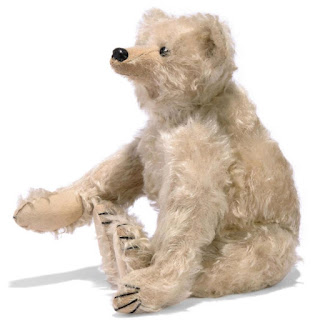It's nothing but Teddy hugs when it comes to this fine fellow. This bear is 35 cm sitting or 50 cm standing, fully jointed, and made from long, thick, white mohair. He is solidly stuffed with excelsior. His paw pads are tan felt. He has five brown hand embroidered claws on each of his hands and feet. Typical to very early Steiff bears, he has long and narrow feet, extra-long arms with prominently curved wrists, and a very pronounced back hump. His sweet and baby-like face comes to life with black shoe button eyes and and a brown hand embroidered nose and mouth. And just when you think things could not get better with him - they actually could.
His little secret just might test your metal. Believe it or not, this bear is rod jointed... dating him right at the turn of the last century. Steiff only produced white rod bears in 1904 and 1905! Steiff's rod jointed bears are extraordinary in their own right. These early bears are best known for their chunky forms, almost (American) football-shaped torsos, simple and somewhat "puppy like" expressions, and gutta percha noses. A somewhat more "typical" white rod bear is pictured here on the left. This photo is from Christies and this bear, which had its original elephant button, sold in 2010 for 13,125 pounds. But as you can see, the rod bear under discussion today really has the face - and the facial stitching - of a c. 1905 to 1912 Steiff bear!
So who nose what's going on here? There are a few possibilities, but it is clear that this all-original bear is a transitional example that spans the company's c. 1903 to 1905 rod bears with gutta percha noses and their c. 1905 onward disk jointed bears with embroidered facial features. As such, it is Steiffgal's best guess that this very bear was one of the very last rod jointed bears made - and at the same time - one of the very first bears to feature a hand stitched nose. How remarkable is that?
Let's take a breather here and talk about gutta percha. Gutta percha is a natural latex product made from the sap of the Palaquium gutta tree. Gutta percha noses were very labor intensive to produce on bears. Each one required an artisan to place individual drops of this black, sticky, rubbery substance on the tip of the bear's muzzle until enough built up to resemble a nose. The artisan also was required to constantly shape the cooling material into a nose shape, which explains why early and original gutta percha noses often are asymmetrical and have fingerprints and nicks on them. You can see a close up shot of a Steiff gutta percha nose here on the left. Richard Steiff himself thought this process was way too time consuming, and insisted that the company's bear production incorporated stitched noses from around 1905 onward.
Steiffgal hopes this discussion on this extremely rare transitional rod bear has been a one in a million experience for you!
Have a question about one of your Steiff treasures? Let's talk! Click here to learn more.














